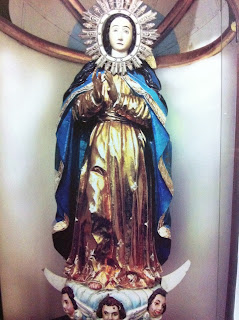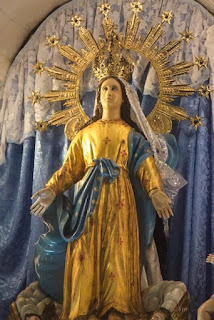Nuestra Señora de la Asuncion de Maragondon - The Miraculous Mother and Patroness of Maragondon, Cavite
 |
| The altar image of Nuestra Señora de la Asuncion de Maragondon or "Birheng Nakatayo" |
The historic town of Maragondon in Cavite province known for its rich history and its role in the Philippine Revolution as the place of exile and execution of Gat Andres Bonifacio. The lasting testament of the town's history is the centuries old church dedicated to the Blessed Virgin Mary under the title of Nuestra Señora de la Asuncion which became a bastion of faith in the said locale and on of the key Marian sites in Cavite.
 |
| The original image of Nuestra Señora de la Asuncion de Maragondon |
The images
There were three images of the Blessed Virgin Mary as Nuestra Señora de la Asuncion de Maragondon, the original altar image, the altar image and the processional image.
The original image is an wooden de tallado image of the Blessed Mother with ivory hands and face of oriental features. She wears a golden yellow dress with a blue cape draped gracefully on her back and shoulders, wears a rostrillo on her face, stands on a cloud base with putti (little angels) and a crescent moon and hands in prayer position. The fingers of the original image were broken since during the early years, devotees would cut out pieces of her hands as if they were "anting-anting" which is such belief was highly discouraged by the Chruch.
A unique feature of the original image is that her face, aside from its oriental features, it seems to evoke two expressions when the beholder looks at the image on a different angle. If the beholder looks at the image on the right, it appears that she is smiling while if it is observed on the left side, she appears to be solemn and serene.
 |
| The altar image of Nuestra Señora de la Asuncion de Maragondon ":Birheng Nakatayo" |
The second image is the altar image which is known as the "Birheng Nakatayo" where the Virgins stands upright, her hands placed downwards like those of the Virgin of the Miraculous Medal, her eyes looking upwards and her head tilted backwards. Just like the original image, the Virgin stands on a cloud base with putti and wears a golden dress yet her blue mantle is draped on her right side and carved as if it was blown by the wind. The Virgin wears a veil, a crown and the diagnostic doce estrellas.
The third image is the processional image known as the "Birheng Nakaupo" which is a de vestir image of the Blessed Virgin Mary seated on a cloud base with putti, her hands raised slightly above her knees looking upwards with a smiling countenance. The Virgin wears a set of vestments made from different materials and designs, a veil and her diagnostic doce estrellas. Unfortunately, the original ivory head of the "Birheng Nakaupo" was sacrilegiously stolen sometime in the late 1980's to early 1990's and its whereabouts are still unknown as of this writing. A wooden replacement was immediately commissioned that can still be seen today. A replica of the "Birheng Nakaupo" was also commissioned for the caracol that is done on the eve of the feast.
The History
 |
| The Processional image of Nuestra Señora de la Asuncion de Maragondon "Birheng Nakaupo" |
The devotion to Nuestra Señora de la Asuncion de Maragondon dates back to 1585 with the arrival of the Franciscan Missionaries in Cavite and began their teaching work in Silang, Indang and Maragondon and Maragondon and its visita was established as part of Silang in 1595 until this mission was turned over to the Jesuits in 1599. The Jesuits formally took over Maragondon in 1611 and in 1614, Rev. Fr. Angelo Amano, SJ made the necessary preparations to establish a parish in the area which took place in 1618 and it was formally established in 1627 under the patronage of the Blessed Virgin Mary as Nuestra Señora de la Asuncion.
The townsfolk of Maragondon bought an image of Our Lady of the Assumption from Manila made of wood and ivory for their visita in 1620. When the chapel became a parish, the current altar image was commissioned sometime in the 1700's which will be later known as "Birheng Nakatayo" then years later the seated processional image known as "Birheng Nakaupo" was commissioned.
In 1633 a new and bigger church was built to replace the older and smaller one, the church stone for some time between 1646 and 1649. The government ordered its demolition for fear that the Dutch, who were at war with Spain, would use it and other churches near Manila for fortification. The orders were apparently implemented because on May 16, 1650 a license was given to the Jesuits to build a house and church of wood in Maragondon to replace the one that had been demolished. Repairs were made on the convent between 1666 and 1672. In 1687 another church was begun although the construction was interrupted; only in 1714 was it completed.
 |
| The Episcopal Coronation of Nuestra Señora de la Asuncion de Maragondon |
The Church was later transferred to the Secular clergy in 1768 then later to the Augustinian Recollects in 1860. The church would later become a shelter and center of the Revolutionaries when Maragondon became a headquarters of the forces of General Emilio Aguinaldo in 1897 and it is said that it was in one of the rooms in the convent that Andres Bonifacio was kept in prison until his unfair trail and later his execution. After the Revolution, the church was later took given to the Diocesan clergy who still administers the people of Maragondon up to this day. Because of the historic significance of the parish, it was declared a National Cultural Treasure in 2001.
Miracles and Church Recognition
Since the enthronement of the image of Nuestra Señora dela Asuncion in Maragondon, numerous miracles were attributed to her miraculous intercession and from granting favors to her devotees, healing the sick, helping childless couples to have children.
One notable account of her miracles is that there was a man from Batangas who visited Maragondon that on his way home, he got caught in the rain and suddenly, a woman carrying a bayong offered him fresh and dry clothes. The man promised to return to Maragondon to return them and when he did, he was surprised that his clothes were at the foot of the image of the Virgin in the high altar.
Due to the numerous miracles attributed to her intercession, the altar image (the "Birheng Nakatayo") of Nuestra Señora de la Asuncion de Maragondon was Episcopally Crowned on December 14, 1997.
 |
| Caracol in honor of Nuestra Señora de la Asuncion de Maragondon |
The devotion at present
The devotion to Nuestra Señora de la Asuncion de Maragondon continues to flourish up to this day. The devotees continuous to fock her church in Maragondon, Cavite and almost each household, street and markers have an image of the Virgin in display or kept in their homes. The feast of the Maragondon's Patroness is celebrated every August 15, the Solemnity of the Assumption of the Blessed Mother and it is celebrated with much festivity with a Caracol held on the eve of her feast and a solemn procession on the feast day itself. Devotees, especially the sick, would visit her church every Second Sunday of Easter to ask her intercession to heal them in their infirmities.
Mary’s Assumption into heaven is a reminder that our faith cannot be abstracted from our experience as embodied persons in the world. If, like Mary, we can reflect God’s holiness in our day-to-day lives, we will also conquer death and be raised, body and soul, to the glory of heaven. Let us strive to emulate Mary’s faithfulness with both our bodies and our souls.
References:
Nuestra Señora de la Asuncion Parish, Maragondon, Cavite, Parish of Our Lady of the Assumption, Maragndon, Cavite, 2010.
Photos
Parish of Our Lady of the Assumption Facebook page
Special thanks to the owners of the photographs used for this blogpost.
+AM+DG+





Comments
Post a Comment